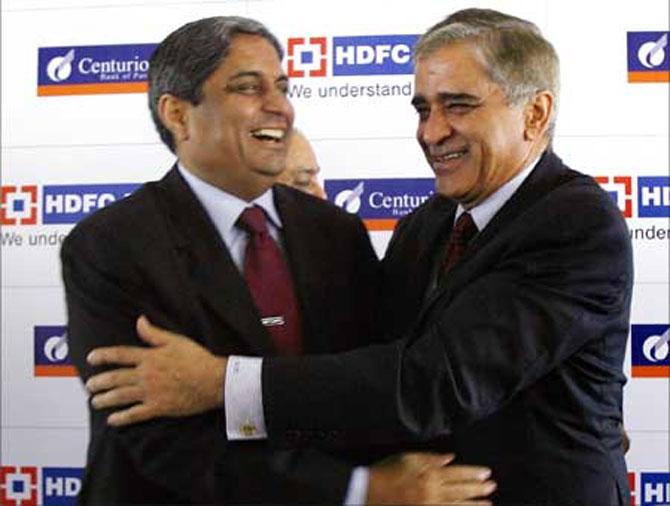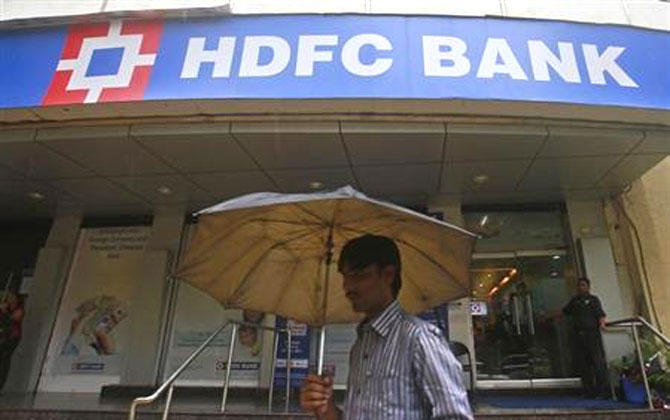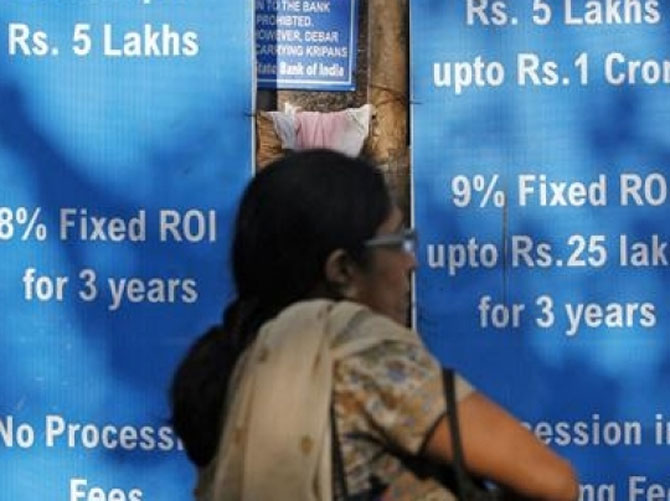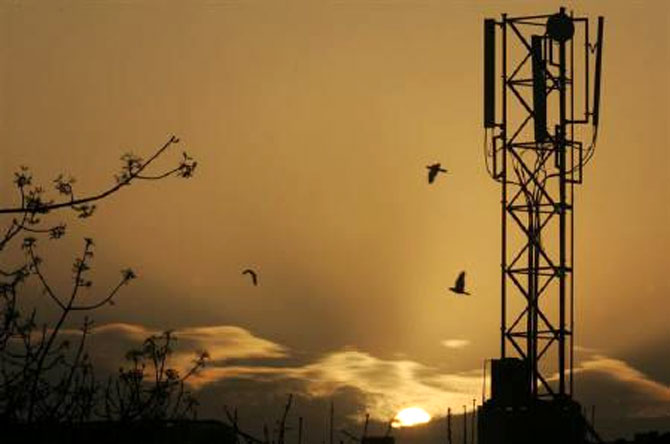Photographs: Arko Dutta/Reuters Shyamal Majumdar & Malini Bhupta in Mumbai
Aditya Puri, the longest-serving head of an Indian bank (he joined HDFC Bank as MD in 1994), says while the worst is over for the Indian economy, people should not expect magic.
In this interview with Shyamal Majumdar & Malini Bhupta, the head of India’s second largest private bank also talks about why he thinks the bank will continue to grow 4 to 5% more than the industry’s growth rate. Excerpts.
You are known to be a CEO with plenty of spare time and even a little laid-back. Is that changing with the stress levels increasing everywhere?
If you ask my people, they will probably kill you. The correct word is organised. I am the most aggressive and demanding taskmasters. I have a lot of time because I manage my time. I do empower my people who are very capable.
I give them the possibility of making a mistake, but I am very demanding. My job description as a CEO requires me to be the prime mover when it comes to strategy. So I have time to myself to write, do gardening, listen to music, enjoy my drinks, and think.
So what are you thinking about these days?
I am thinking about what will happen three years from now -- in terms of digitisation, big data and customer expectation. Are we in the right segments? Who my competitor will be a few years down the line – will it be the technology companies, will it be the telecom companies or will it be banks?
Today the customer is experiencing my brand at so many touch points – be it ATMs, branches, online etc. I have to have a sales force that can deliver what the customer wants. Rural market is something that is occupying my mind as it is a completely different model.
The bank will have to sell products like a McDonald’s sells hamburgers. McDonald’s asks the consumer whether he wants a hamburger with cheese, with tomato or without tomato. We will also have to deliver products as and when and how the customer wants.
If he wants a car loan, somebody should call him within three hours, give details, collect documents and facilitate delivery of the car. And for all this to happen, my sales people should have the backing of the organisation to deliver within a finite period.
Click on NEXT for more...
What HDFC Bank must learn from McDonald's
Photographs: Danish Siddiqui/Reuters
Are your sales people becoming too aggressive? RBI fined your bank Rs 5 crore for mis-selling.
We were not fined for money laundering or mis-selling. We were fined for things like more diligence on cooperative banks and insurance. We have been told that even if it is insurance, we will be liable if it has originated from us. We have now put in place tight processes, because you don’t want it to affect your brand.
How is HDFC Bank building capabilities to service the rural consumer?
We have been building this for the last four years. If you see the McKinsey report, it says only 15% of the semi-urban and rural people have access to organised finance on the asset side (loans) and only about 40% have access to organised finance in terms of liabilities. Obviously, the opportunity is immense.
First we decide on products, delivery models and collection methods. Then we look at whether these customers can be served through the centralised backend or you need credit hubs, which requires decentralisation.
You need common collection systems for different products. You learn from small pilot projects. We run projects for a year and then scale it up.
Many bankers say they do not want to go to rural India because of poor credit culture.
We have not faced a problem. Rural population does not have a higher proportion of delinquencies. We started two-wheeler finance eight years ago. When we do pilots, we understand customer behaviour and then we arrive at rates or ask for higher security. But you cannot write off 65% of the population.
Why is HDFC Bank’s presence in overseas markets minimal?
Our presence overseas will remain minimal and there are enough reasons for it. Have Indian corporates gone overseas? Yes, but is it a stampede or a few swallows that have come announcing summer? Just as some of my peers have decided not to go to rural India, we have decided not to go overseas.
Click on NEXT for more...
What HDFC Bank must learn from McDonald's
Photographs: Danish Siddiqui/Reuters
HDFC Bank is now known as a 30% bank, thanks to your consistent record in delivering 30% profit growth quarter after quarter. What is it with this number?
We are neither a 20%, nor a 30% bank. We are a very consistent bank in terms of ensuring that we grow as India grows. I told analysts that you must be living in cuckoo land if you think we can grow at the same rate when the GDP rate has halved.
But your profitability has come down marginally to 27% even though GDP growth has halved.
The secret is that the banking system’s growth will be 3-3.2 times GDP growth and we will grow four to 5% more than that. The secret is that we have the widest product range and have a brand that is accepted widely in India. We are established in semi-urban and rural. 55% of our customers are retail. So it’s obvious that we will grow faster than market.
What’s your take on the interest rate scenario, with RBI focusing on inflation?
My view is that rates may not come down in a hurry but we are near the top. If the harvest brings food inflation down, then you will see softening of stand. If this does not happen, RBI cannot soften its stand.
But isn’t industry crying over high interest rates?
Industry is always crying. They would raise their prices, but banks should not increase interest rates, right? Have they kept their prices constant?
Click on NEXT for more...
What HDFC Bank must learn from McDonald's
Photographs: Danish Siddiqui/Reuters
What’s your take on the reluctance of Mahindras and the Tatas to enter banking?
There is a very large pre-emption of deposits by the government, which is a drag. If you do not give forbearance to large corporates that have finance companies to convert into banks, and they have to maintain SLR, CRR and priority sector lending, it cannot be feasible to convert.
Then there is a very strong holding company structure. I think you should give forbearance. The purpose is to take banking to the unbanked areas which is serviced by the unorganised sector. There are people who could do it faster, but if you make it difficult they won’t do it.
When do we see HDFC and HDFC Bank merge?
I just spoke to you about the forbearance part. The same issues that apply to Tatas and Mahindras apply to us as well. We will consider it only when it makes sense.
Mobile phone players and technology firms have ambitions of entering the financial services space. Do you see distribution of financial products undergoing change because of technology?
It should have already changed. From detecting a trend to it becoming of any significance financially takes five to six years. Going forward, there are issues on regulation. Mobile phone companies can become payment system and these things take time. These things can also require collaboration between companies and they are never easy.
Click on NEXT for more...
What HDFC Bank must learn from McDonald's
Photographs: Danish Siddiqui/Reuters
What about existing tie-ups with telecom players?
What do they want to do? Do they want to become a bank or become a payment gateway? They have to identify what they want to do. The fact is there are more mobile phones than there are bank branches; so the idea was to try and see if banking products can be taken to the last mile in a cheaper manner. That would require collaboration. Their discussion is on whether there is enough of a profit in the cake.
Do you see more restructured assets slipping into NPAs?
It all depends on how things move. If you see clearances happening and projects taking off, then the assets are good. The longer it takes, the greater the chance of they slipping into NPAs.
What is the sense you are getting when you meet corporate clients?
The sense is that worst is over. But people are expecting magic. It does not happen that way. If a project is approved today, it takes 12-18 months to come up to the stage of investment. The uptick will come but not immediately. Absolute greenfield projects are not going to happen with elections around the corner.
You are due to retire in 2015. What’s your succession plan?
Who said I have to retire that time? If both me and the board feel, I should continue, then I will.







article